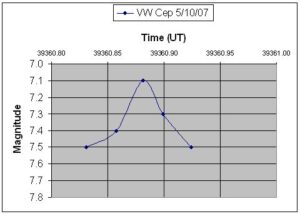VW Cep Observing Notes 2007-2008
W Ursa Majoris Stars are contact eclipsing binaries with very short periods (fractions of a day), and because they are so close together the stars themselves are distorted, leading to continuous variation rather than the sharp dip during eclipse that Algol-type eclipsing binaries show.
One of these stars is VW Cephei, which is one of the brightest of this class of star, varying between magnitude 7.2 and 7.7. The variation is small (making it a challenge to observe visually) although noticeable, and as the period, covering both a primary and secondary eclipse is around 6.5 hours, it is possible to see a lot of change in a single night.
Initially I faced a few problems in plotting magnitude variation, but then I noticed that the comparison star magnitudes as listed in Hipparcos and elsewhere were somewhat different from those on the BAA chart. When I starting using the Hipparcos magnitudes, it became easier to see a light curve.
Initially I faced a few problems in plotting magnitude variation, but then I noticed that the comparison star magnitudes as listed in Hipparcos and elsewhere were somewhat different from those on the BAA chart. When I starting using the Hipparcos magnitudes, it became easier to see a light curve.
The diagram shows my most successful night’s observations in October 2007
VW Cephei Light Curve : Image Credit Steve Woodbridge

This star has a high northerly declination and so is circumpolar so is very amenable to CCD observations, and indeed to digital camera observations. It is nice because every clear night you can trace out the fluctuations across much of a cycle, and it gives you a chance to put your CCD to use in another way that can help contribute to scientific study.
Some useful Links
British Astronomical Association (BAA) Variable star section
American Association of Variable Star Observers (AAVSO)
by Steve Woodbridge
Aug 2009
